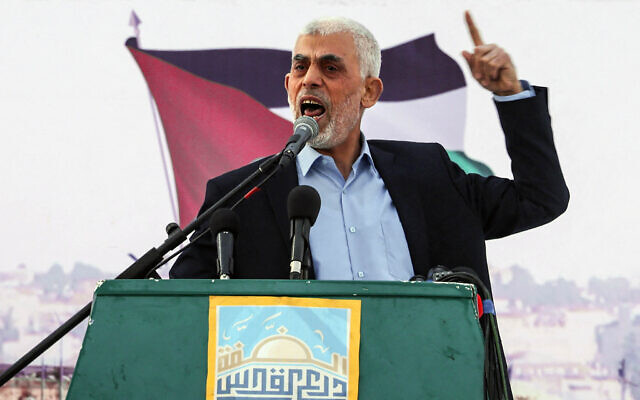NYT: US giving ‘priceless’ help to Israel in hunt for Sinwar, but he remains elusive

Israel and the US have been cooperating for more than 10 months in the hunt for elusive Hamas leader Yahya Sinwar, The New York Times reported on Sunday, detailing the intensive effort to find the architect of the October 7 invasion and slaughter in southern Israel.
Citing two dozen unnamed officials from Israel and the US, the report said the two countries — both of which classify Hamas as a terrorist organization — have jointly poured vast resources into the hunt for Sinwar, including “ground penetrating radar” supplied by the US.
However, despite the intense cooperation, which one Israeli official described to the newspaper as “priceless,” another source familiar with the arrangement said it was “very lopsided,” with Israel gaining far more from the US than it was sharing in return.
According to this source, the Americans have shared information leading to Hamas leaders other than Sinwar, hoping to receive reciprocated Israeli intelligence that would lead them to the remaining American hostages in Hamas captivity, but Israel has not been as forthcoming.
Describing the joint effort, the report says a joint Israeli-American intelligence force was set up and tasked with monitoring Sinwar’s communications, which were conducted electronically at the beginning of the war in Gaza but have since been shifted to couriers, due to the scarcity of fuel to power generators and to evade interception.
While Sinwar was still communicating with his organization electronically, the team was able to monitor Sinwar’s calls with other Hamas officials.
During this period, Defense Minister Yoav Gallant pushed his government to okay shipments of fuel into Gaza to power cell networks needed to keep Sinwar communicating electronically, so Israel could continue eavesdropping on the Hamas leader, the New York Times reported.
Though they could not pinpoint the Hamas chief’s location, the intercepted communications allowed the teams to piece together a picture of his life in Hamas’s tunnels, including discovering that Sinwar regularly monitors Hebrew media and watches the 8 p.m. Israeli news, according to the newspaper.
Gallant initially ordered fuel supplies to Gaza cut along with other goods on October 7, arguing they would be used to bolster Hamas and would power generators to keep oxygen flowing into the group’s vast tunnel system.
In November, following heavy international pressure, the war cabinet voted to begin allowing in fuel shipments, over the objections of right-wing members of the government who have pushed to cut any aid into Gaza until all hostages are released.
Despite the shipments of fuel, Sinwar long ago stopped communicating electronically, making it much more difficult for officials and ceasefire negotiators to track him, the report noted.
The US and Israel believe Sinwar spent the first weeks of the war hiding in a tunnel under Gaza City, where the report said IDF troops found footage of Sinwar moving his family to another locale.
From Gaza City, Sinwar was believed to have moved to tunnels under Khan Younis, where he came close to being captured at the end of January but fled just before the army raided his bunker.
According to the NYT, this escape was hasty, with Sinwar leaving behind roughly a million dollars in shekels in the tunnel.
As part of its war with Hamas in Gaza, the IDF has eliminated many members of the terrorist organization’s leadership over the last 10 months. Included on the list of targets were the organization’s top three leaders, Sinwar, former political leader Ismail Haniyeh, and Mohammad Deif.
Deif was killed in an Israeli airstrike in Gaza in July. Haniyeh was killed in an explosion in Tehran at the end of the month, but Israel has not officially confirmed any involvement in the assassination. Now, Sinwar, who replaced Haniyeh as Hamas’s political leader, is the most senior leader on the list who has yet to be captured or killed.
Some sources in the NYT report believe eliminating Sinwar is the achievement Israel needs to declare that Hamas has been fully defeated, and will make Prime Minister Benjamin Netanyahu more amenable to ending the military campaign in Gaza.
It is unclear, however, how Sinwar’s death would affect negotiations for a hostage-for-ceasefire deal, as the report says the Hamas leader has had to okay every development in the talks in Doha and Cairo.
The war in Gaza broke out on October 7 following an unprecedented surprise attack by Hamas in which terrorists rampaged through southern Israel murdering some 1,200 people, mostly civilians, and taking 251 hostages. The attack was widely believed to have been engineered by Sinwar, who was released from Israeli prison as part of a 2011 prisoner exchange for IDF soldier Gilad Shalit.
In response to the attack, Israel launched a ground invasion of Gaza with the proclaimed objective of dismantling Hamas and getting the hostages back.
The Hamas-run Gaza health ministry says more than 40,000 people in the Strip have been killed or are presumed dead in the fighting so far, though the toll cannot be verified and does not differentiate between civilians and fighters. Israel says it has killed some 17,000 combatants in battle and another 1,000 terrorists inside Israel on October 7.
Israel has said it seeks to minimize civilian fatalities and stresses that Hamas uses Gaza’s civilians as human shields, fighting from civilian areas including homes, hospitals, schools, and mosques.
Israel’s toll in the ground offensive against Hamas in Gaza and in military operations along the border with the Strip stands at 339.
culled from THE TIMES OF ISRAEL

